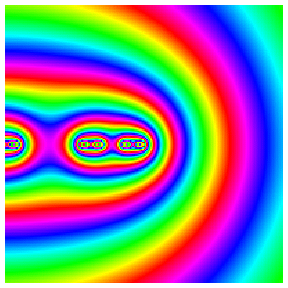
Cantor Potential
The "middle third" Cantor set is a fractal defined by taking a line
segment (say between x=-1/2 and x=1/2), removing the middle third,
then removing the middle third of the remaining pieces, ad infinitum.
It consists of an uncountable number of disconnected points.
The animation shows the electrostatic potential of a uniform charge
distribution on the Cantor set, zooming into one edge.
The colours represent a logarithmic scale, so that identical colours
correspond to the factor 3/2 ratio between potentials at equivalent
points of the scaling transformation of the fractal, that is a factor
3 in distance. The potential is computed recursively using the equation
V(x,y)=3[V(3x-1,3y)+V(3x+1,3y)]/2
with V approximately given by 1/sqrt(x^2+y^2) at large distances. The
relevant paper
Potential theory and analytic
properties of a Cantor set computes an exact expansion
of V(x,y) in horizontal and vertical directions from the end of the fractal,
including logarithmic oscillations (too small to observe here) similar
to those found in galaxy distributions and the stock market. A recent
paper Fractal asymptotics gives
references and further applications.
The sound (if you can hear it) is a representation of zooming into the
Cantor set, with decreasing pitches a factor of three apart.
Back to home page
